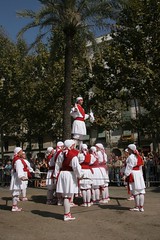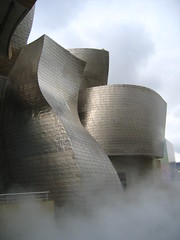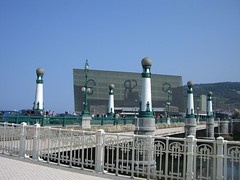This comes to us thanks to our friend Txabi:
The Basque Struggle against French, Spanish Assimilation
France's absolutist monarchy found strong opposition in the northern Basque territories in France. The mercenaries of Louis XIV killed all the farmers in Zuberoa who rebelled against the policies of centralisation imposed by the monarchy. Bernard Goyhenetxe who led the rebellion in Zuberoa was guillotined.
Many of the Basque revolts against French centralisation were led by women: Mugerre and Iturbe in 1696; Ainhoa in 1724; Baiona and Donibane Garazi in 1728. In 1784, hundreds of women in Hasparren challenged 150 'grenadiers' and 5 brigades of the marechaussee. The intervention of the village priest prevented a confrontation between the women and the French forces.
The French National Assembly decreed the abolition of the feudal regime and the tithe on the night of August 4, 1789 - happily for everyone including the Basques. However, it also abolished the constitutions of the Basque territories of Navarre, Lapurdi and Zuberoa. On August 26 it introduced the "Declaration of the Rights of Man and the Citizen." The Constituent Assembly furthered these reforms, proclaiming the revolutionary idea that people had the right of self-determination.
In 1790, the Basque territories were incorporated, together with Bearn, into the Departement de Basses Pyrenees.
A new assembly (the Convention) met in September 1792. It proclaimed an end to the monarchy and established the republic. The convention introduced governmental limitations on prices, declared that education should be free and compulsory, imposed taxes on the rich and made other economic and social "reforms."
The Convention took terrible measures in the Basque territories whose constitutions had been abolished by the National Assembly. Citizens of Sara, Ainhoa, Azkain, Itsaso, and Ezpeleta, without distinction of age or sex, were deported to Landes and Gers. Suspects in Kambo, Biriato, Macaio, Larresore, Medionde and Lohosa were held prisoners in churches. More than half of the deportees died of starvation, and illnesses from lack of hygiene. Survivors returned to their homes only to find these had been plundered.
The Revolution ended in 1799 when Napoleon Bonaparte entered Paris and was crowned First Consul. Napoleon established a powerful central administration and a strong code of law. He introduced the `department prefets' and obligatory military service outside the provinces. French became the only official language of France.
Among its positive aspects, the French Revolution abolished the feudal regime and monarchy. It achieved the victory of liberalism and of an individual conception of society. In the Basque territories, however, "revolution" centralism suppressed the collective rights of a community: its language, laws, and institutions.
The society that emerged in the Basque territories after the French Revolution was in the hands of a small group of nobles, landowners, and merchants who were unable to guarantee the development of an industrial or commercial capitalism. Poverty and underdevelopment during the last centuries generated massive migration of their citizens to Bordeaux, Paris, and especially, to the United States.
In Spain, the main agency for the diffusion of the ideas of the Englightenment and liberalism into Araba, Bizkaia and Gipuzkoa was the Real Sociedad Bascongada de Amigos del Pais (Royal Basque Society of Friends of the Country), founded by the Basque aristocracy in Azcoitia in 1764. This society provided Carlos III (1759-88) - the same monarch who made Bolivian indian females wear dresses copied from the regional costumes of Basque and Andalusian peasant women - with the model for the subsequent establishment of similar societies throughout Spain. The main attentions of the society were oriented toward the modernization of agriculture and the Basque metallurgical industry, the two main pillars of Spanish Basque aristocratic income.
This Spanish Basque elite - both urban and rural - regarded itself as the direct descendants of those, "uncontaminated by either Jewish or Moorish blood", who had reconquered Spain from infidels and restored civilization and Christianity to the country. Although many were familiar with Euskera, Spanish was their preferred language both domestically and publically. The nouveau riche had the most costly foods brought from France; Europe's top couturiers cut their dresses and outfits; and they sent their children to study at British and French schools. They imagined themselves at the pinnacle of European culture.
In 1767 the Society, promoters and sponsors of the Hirurak Bat (Baskongadak as the Basque Country), founded the Academy of Vergara, the first secular school established in Spain. This illustrious sector also gave the "entrepreneurial inspiration" to the Royal Guipuzcoan Company, a Basque controlled trading company in Venezuela. The Royal Guipuzcoan Company's publicity brochures pointed with pride to the company's Venezuelan philanthropies much as, two centuries later, the American Standard Oil proclaimed its own virtues. The profits extracted from one of the world's reachest countries by these pundits, in proportion to the capital invested, are only comparable with those obtained by old-time slave merchants and pirates.
Navarre's hour of revenge seemed to have stricken in 1833 when peasants, artisans and small traders arouse in arms for equality and social justice and in defense of their fueros or laws.
With the ascendance of the Bourbon dynasty to the Spanish throne in the eighteenth century, state centralism became an overriding goal. The Spanish Liberal Constitution drafted by Joseph Bonaparte and ratified by the Cortes in 1812 aroused fierce opposition among Basques.
Known as the Carlists Wars (1833-1872), these guerrilla wars took the form of a popular uprising in the defence of Basque liberties and laws as opposed to Spanish centralism. Liberalism which sought the disentailment of common lands together with political and economic uniformity was an obvious political creed for the Basque urban bourgeoisie. The Basque urbanites and their liberal cronies in Madrid united to attack frontally the Basque political system based on fueros. Peasants, artisans, and small traders were fiercely opposed to integration into a Spanish national market. Integration meant the free import of Castilian cereals and livestock which would increase competition and further decrease prices. Imposition of Spanish customs duties would also result in a dramatic increase in taxation on rural consumption. In addition, the sale of common lands, which had intensified throughout the early 19th century due to liberal disentailment legislation, had already undercut a crucial buttress of
the Basque peasant economy.
The liberal Basque urbanites saw in the rural Carlists only a symbol of barbarism, the backwardeness and ignorance, the anachronism of the countryside confronting urban civilization, the beret and the abarketa against the frock coat, the stone and the knife against the troops of the line, Euskera against Spanish, illiteracy against the school. Such scorn and hatred were an expression of antipatriotism clearly tinged with political economy.
The first Carlist war broke out in 1833 and ended in 1839 with the Treaty of Bergara. The Carlists wars developed in the Spanish State but fundamentally in the three Basque provinces of Araba, Bizkaia, and Gipuzkoa and in Navarre, the conquered Basque state.
The Carlist leadership was based in Navarre. Fearing the end of their regional autonomy, Basques aligned with the Catholic church and the followers of Don Carlos, a contender to the Spanish throne, in a war against the Liberal central government. For seven years, Carlists organized their own state which spanned the Basque speaking areas of the southern territories and had the massive support of the peasants. The Carlist army comprised of volunteer Basque peasants. Historians think that the military potency of Carlism resided in the guerrilla tactics employed by its army. The first Carlist war ended four years after the death of the Carlist General Zumalakarregi.
The Treaty of Bergara offered to guarantee the Basque fueros or laws. However, the Law of 1839 which confirmed the treaty stated that "[t]he Fueros of the Basque provinces and Navarre are reaffirmed unless they are prejudicial to the constitutional unity of the monarchy." Navarre never accepted the treaty but Araba, Bizkaia and Gipuzkoa went along. There was a split between the Basque traditionalists of the interior and the liberals of the cities of Bilbo and Donostia.
Spain was paving the road to the annexation of Navarre. In 1841 the Spanish government passed the law of Modification of the Fueros (aka Pacted Law) and Navarre was transformed from a viceroyalty into a province. All legislative and executive powers were transferred from the Assembly to the Spanish parliament and government. A Provincial Assembly, an administrative body with no control over public funds, was set up as the main institution of Navarre. The establishment of compulsory military service caused uprisings during the following eight years. In 1833, a royal charter restructured the Spanish state into forty nine administratively equivalent provinces. The "Hispanic" character of Navarre, the dream of the Spanish conquerors, had come true.
The Land Reform of Madoz of 1855, despite its liberal and progressive ambitions, prepared the way for the nascent mercantilist oligarchy. Basque peasants and artisans, whose communal lands passed into the hands of the commercial and landed elites, would be turned into teeming proletariat of the Spanish economy which was to devastate the Basque countryside.
The popular insurrection, however, was used by the Carlist leadership to advanced the political ambitions of Don Carlos, brother of the deceased Spanish king, Fernando VII, allied against the defenders of Isabel II, the unanticipated daughter of the late king and the wife of his old age, Maria Cristina of Naples.
Regrettably the protection of the "Basque laws" was not the main goal of the Carlist leadership, but the religious unification of Spain. A second Carlist War broke out in 1872 and ended in 1879 with the defeat of the Carlists. As a consequence of the Carlist defeats, the fueros of Araba, Bizkaia and Gipuzkoa were abolished. Basques lost their leadership and their culture and language became under attack in their own homeland. In 1893, a massive rally called the 'Gamazada' took place in Pamplone (Iruña in Basque language), the capital of Navarre. The rally gathered 80,000 people protesting against the attempts of Spain's minister Gamazo to abolish Navarre's fiscal system. This was the first popular mobilization uniting the Navarrese
people in the defense of their laws.
From 1876 onwards, the integration of Spain's Basque territories into a national market made possible the emergence of the first monopolies of the Basque industrial and financial oligarchy in Bizkaia, centered on five families linked by marriage. With the abolition of the Basques fueros there was no obstacle to free trade and the intensive extraction of Bizkaian iron ore. Under the foral regime the mines were municipal property and rights of usufruct were available to all municipal residents.
The Spanish Basque oligarchy was rewarded with an instrument for increasing its profits and economic power: a special fiscal and administrative regime - the economic concerts - for Araba, Bizkaia and Gipuzkoa. This regime allowed the Spanish Basque oligarchy to control the Provincial Councils (Diputaciones) and reduce fiscal pressure on industrial production which was to have repercussion on the working class and the popular strata.
"Very importantly, however," writes Marianne Heiberg, "the Basque urban liberals were dedicated to preserving within the new system of Spanish constitutional unity the one aspect of the foral regime which had been of considerable importance to their interests: fiscal autonomy." The Spanish parliament approved a special fiscal and administrative regime - the conciertos economicos - for Araba, Bizkaia and Gipuzkoa. This regime enabled these three Basque provinces to negotiate their own taxes with Madrid and pay a fixed sum into the Madrid treasury. The quotas agreed upon, which were significantly inferior to the taxes paid out by other Spanish provinces, were to be raised in whatever manner the Basque provincial governments deemed suitable.
The Basque oligarchy became a Spanish national bourgeoisie and opted for the construction of a Spanish capitalist state. Industrialization was largerly confined to the areas surrounding the city and port of Bilbo and, to a lesser extent, specific urban centers in Gipuzkoa. Navarre and Araba remained mainly rural until the 1950s. The heart of Basque industrial potential lay in the rich deposits of high quality iron ore located in the mines near Bilbo. This way, from the Adour river to the Ebro, from Baiona to Bilbo, liberalism and the process of consolidating the capitalist mode of production brought with it the domination of the markets, cities and ports by the bourgeoisies of the Basque territories.
Bibliography: Mikel Sorauren, Historia de Navarra, el Estado vasco, 1999; Tomas Urzainki, La Navarra maritima, Pamiela, 1998; Roger Collins, The Basques, Basil Blackwell, 1986; Jean-Louis Davant, Ebauche d'une histoire du peuple Basque, in Euskadi en guerre, Ekin, 1982; Marianne Heiberg, The Making of the Basque Nation, Cambridge University Press, 1989; Luis Nuñez Astrain, La Razón Vasca, Txalaparta, 1995.
~ ~ ~







